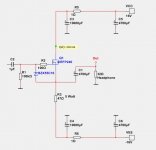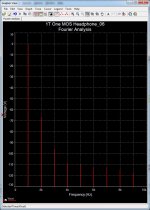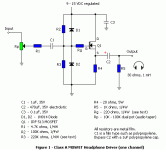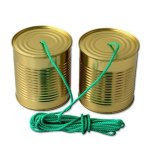One MOSFET and One resistor ...
This amplifier is for you who have a headphone: 8, 16, 32, 60 or 64 Ohm impedance.
The trafo is 2x12VAC.
The MOSFET can be any TO-220 or TO-247.
For example IRFP240, IRFP140, IRFP044, IRF540. (IRF520 and IRF610 gives a little more distortion = more MOSFET sound)
The resistor should be 5 Watt.
If you have some MOSFET laying around, this project is for you.
You get good use of your MOSFET.
I have not built it. But the SPICE test shows it is a good, solid and fun design.
It works 🙂
This amplifier is for you who have a headphone: 8, 16, 32, 60 or 64 Ohm impedance.
The trafo is 2x12VAC.
The MOSFET can be any TO-220 or TO-247.
For example IRFP240, IRFP140, IRFP044, IRF540. (IRF520 and IRF610 gives a little more distortion = more MOSFET sound)
The resistor should be 5 Watt.
If you have some MOSFET laying around, this project is for you.
You get good use of your MOSFET.
I have not built it. But the SPICE test shows it is a good, solid and fun design.
It works 🙂
Attachments
Hello!
It is the first scheme I see that is powered by +0- that has a capacitor on the output.
Why this?
It is the first scheme I see that is powered by +0- that has a capacitor on the output.
Why this?
I hope someone build this
and report the sound.
It is an easy project if you have one MOSFET per channel.
and report the sound.
It is an easy project if you have one MOSFET per channel.
A balanced HP amp that Hugh and I played with some 10 years ago when balanced HP amps were still a novelty/

In simulation, the THD is rather high (>0.1% at 1V rms out). Is the idea behind this standalone MOSFET buffer to put a bit of euphonic 2nd harmonic into your headphone listening?
Reminds me moosefet circuits...One MOSFET and One resistor ...
This amplifier is for you who have a headphone: 8, 16, 32, 60 or 64 Ohm impedance.
The trafo is 2x12VAC.
The MOSFET can be any TO-220 or TO-247.
For example IRFP240, IRFP140, IRFP044, IRF540. (IRF520 and IRF610 gives a little more distortion = more MOSFET sound)
The resistor should be 5 Watt.
If you have some MOSFET laying around, this project is for you.
You get good use of your MOSFET.
I have not built it. But the SPICE test shows it is a good, solid and fun design.
It works 🙂
Attachments
Yup, the only difference being the one in this topic has a bi-polar PSU, while the two "moosefet" examples in the previous post have single-ended PSUs so the MOSFET has to be fixed biased. Otherwise they're the same.
Reminds me a bit of the Szekeres amplifier circuit posted long ago on Headwize. I believe biasing was handled differently with that one, though. There were several alternate versions of that circuit explored in footnotes and addendums, including a DC coupled variant.
Edit: looks like someone posted one of the variants from Headwize above, so I'm late to the party.
Edit: looks like someone posted one of the variants from Headwize above, so I'm late to the party.
I push this thread, because one transistor circuits are always interesting.One MOSFET and One resistor ...
This amplifier is for you who have a headphone: 8, 16, 32, 60 or 64 Ohm impedance.
The trafo is 2x12VAC.
The MOSFET can be any TO-220 or TO-247.
For example IRFP240, IRFP140, IRFP044, IRF540. (IRF520 and IRF610 gives a little more distortion = more MOSFET sound)
The resistor should be 5 Watt.
If you have some MOSFET laying around, this project is for you.
You get good use of your MOSFET.
I have not built it. But the SPICE test shows it is a good, solid and fun design.
It works 🙂
Hope somebody finds this worth reading.
I am currently listening to MosFets in TO-220 enclosures. I bought them a year ago to compare their sound, but I never got to it. The TO-220s consistently fail to find a full-bodied, contoured sound, earlier also. I have just heard: IRF 510, 520, 530, 530N, 530VIS, 610VIS, 630, 710, 820.
I would buy FullPak for headphones, or smaller ones.
I would buy FullPak for headphones, or smaller ones.
I can still add - just heard: IRLZ24NIR, IRLZ34N, IRFZ34, IRFZ44N, IFL510VIS, UF640L-TA3, 2SK2545, STPN52K3.
I would make recommendations - IRF530 (wide, rolling), IRF820 (clean, open, elaborated, more focussed than IRF530); IRLZ24N (like "tok tok", wooden, tact, "authentic"), IRL510VIS (more focus than IRF820) - if I didn't know that every batch can sound different. Whereby 2SK2545, STPN52K3 go in the direction of BjT, but sound a little less clean in the fundamentals and deepths (compared with a TIP 31C).
Keep your hands off TO-247 types.
I would make recommendations - IRF530 (wide, rolling), IRF820 (clean, open, elaborated, more focussed than IRF530); IRLZ24N (like "tok tok", wooden, tact, "authentic"), IRL510VIS (more focus than IRF820) - if I didn't know that every batch can sound different. Whereby 2SK2545, STPN52K3 go in the direction of BjT, but sound a little less clean in the fundamentals and deepths (compared with a TIP 31C).
Keep your hands off TO-247 types.
Hi All,
I started to look for something simple I can (re)start my DIY journey with, and found two intriguing "projects", looking very similar to each other...
Comparing this hybrid HP amp using a FET and a tube with the right side picture with a single FET from @adason 's post above, my question is, what is the advantage adding a pre-stage(?) like a tube, or another FET to the single component apmlifier already capable of driving a headphone?
What do they bring to the table?
Thanks!
I started to look for something simple I can (re)start my DIY journey with, and found two intriguing "projects", looking very similar to each other...
Comparing this hybrid HP amp using a FET and a tube with the right side picture with a single FET from @adason 's post above, my question is, what is the advantage adding a pre-stage(?) like a tube, or another FET to the single component apmlifier already capable of driving a headphone?
What do they bring to the table?
Thanks!
With FET or Tube in front there will be an impact of the sound.
If it is for the better is questionable.
I say if you do not need some voltage gain, one MOSFET is enough.
For 8, 16, 32 or 60 Ohm headphones there is usually no need for Vgain.
If it is for the better is questionable.
I say if you do not need some voltage gain, one MOSFET is enough.
For 8, 16, 32 or 60 Ohm headphones there is usually no need for Vgain.
One answer could be: A follower as shown (both pics: mosfet foll.). Simply: some sources are not loud enough to achieve the desired high levels with a follower.Hi All,
I started to look for something simple I can (re)start my DIY journey with, and found two intriguing "projects", looking very similar to each other...
Comparing this hybrid HP amp using a FET and a tube with the right side picture with a single FET from @adason 's post above, my question is, what is the advantage adding a pre-stage(?) like a tube, or another FET to the single component apmlifier already capable of driving a headphone?
What do they bring to the table?
Thanks!
The advantage of followers: they do not "distort" audibly relevant, compared to "amplifiers". The best, simplest followers sound very pure and almost magical. But an additional amplifying stage also has disadvantages: Adding signal modulation through parts characters due to material, shape, size, mass, diameters and more.
Thank you very much indeed!With FET or Tube in front there will be an impact of the sound.
If it is for the better is questionable.
I say if you do not need some voltage gain, one MOSFET is enough.
For 8, 16, 32 or 60 Ohm headphones there is usually no need for Vgain.
I might step up my headphone to higher Ohms so I will have an excuse to add parts for the gain...
- Home
- Amplifiers
- Pass Labs
- SOMOS. Sound of One MOSFET Headphone Amp




